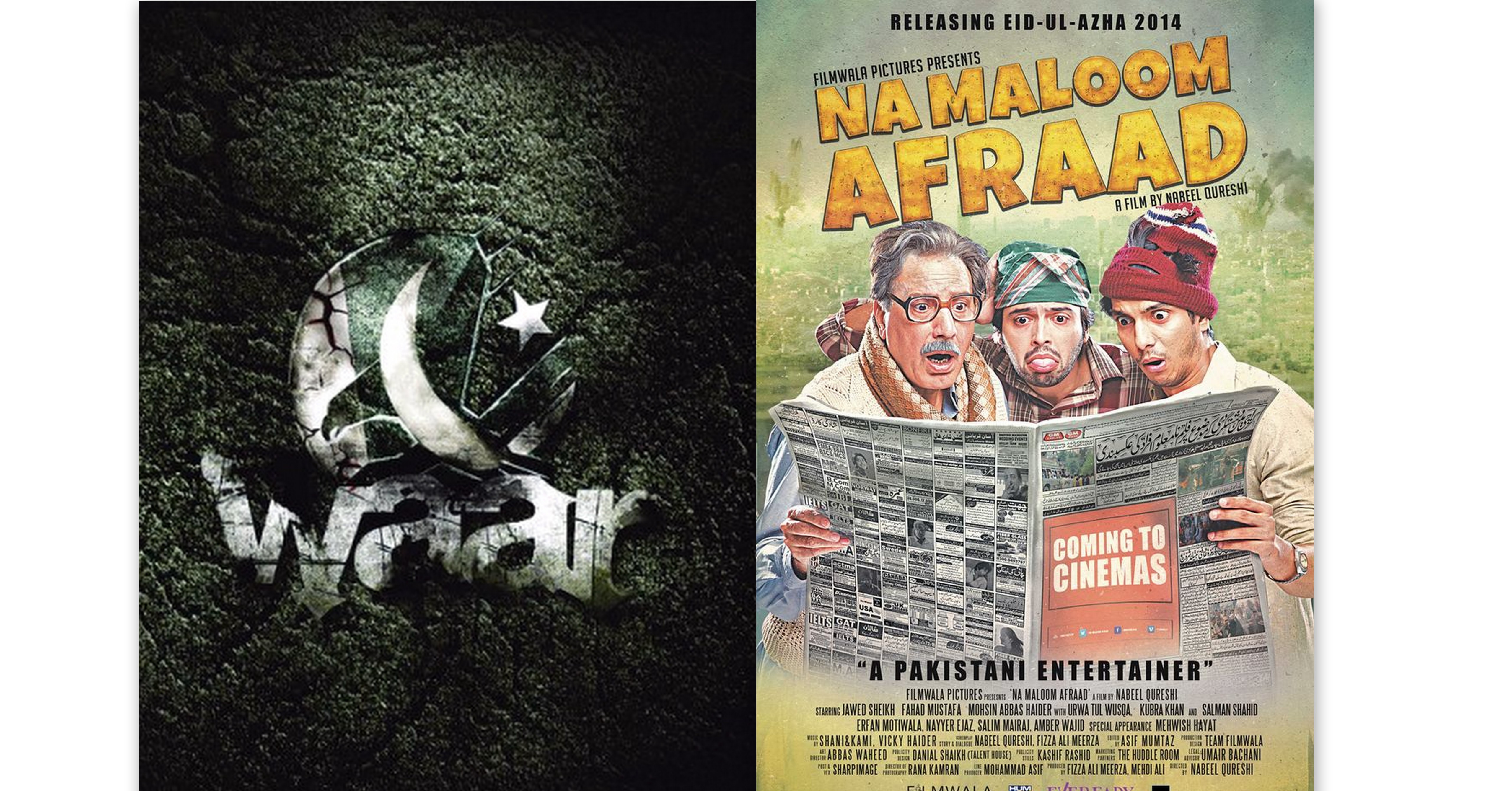by Momin Ali Munshi
It was early 2014 when we at Galaxy Lollywood first heard of the film “Na Maloom Afraad” after reports came out that the film would be releasing sometime at the end of the year.
“Huh, another film that will never make it to the cinemas ” we thought.
“At least not until it gets postponed a few times” we said to ourselves while writing it off as another “on paper” project that was too ambitious to materialize.
However we were in for quite a shock when the film came out with its trailer, announced its release date and actually ended up releasing on the mentioned date. Though the buzz around the film was high and the trailer had won the audiences over but the sword that was “Operation 021” was still lingering over Na Maloom Afraad’s head. And why not? For the film ‘O21’ was bringing Lollywood’s beloved hero back to the silver screen after 2013’s mega blockbuster Waar and was touted to recreate the Waar magic.
So came October 6 2014 and both the films released in cinemas. The cash registers were set ringing and the entire country was celebrating the release of two major Pakistani movies on the same day, something that hadn’t happened for years. However with each passing day, while NMA’s position grew stronger, O21 sort of fizzled away in the background. While people could not get over the fact (us included, guilty as charged) that a film starring mere new-comers had managed to slay the mega giant that is Shaan, NMA was yet to show its real magic. After beating O21 at the box-office, NMA still was very much present in the race and weeks passed by but it maintained its position at the box office.
So much so that NMA completed its century in cinemas, a feat that was surely worth celebrating. But NMA still had a few tricks up its sleeve and shocked everyone when it completed more than 200 days in cinemas that too with packed houses (Last day in cinemas was 30 April). If that does not spell the word ‘success’, then we don’t know what else does. Here in this piece we present our argument and state why Na Maloom Afraad is the biggest hit to have come out of Pakistan in recent times….
What do we mean by recent times you ask? Well, we are referring to this new wave of cinema that was somewhere started by Khuda Kay Liyay in 2007 and more so this “recent” is about 2013, 2014 and the current year where we have now finally started having multiple releases. To be honest, we are trying to challenge all the buzz which says that “Waar” is the most successful film. But in this piece we want to present our argument that NMA is the superior one and in doing so we will also analyse the major advantages that Waar had which gave it an edge over NMA. So without much wait lets start:-
1. The Money Factor
Na Maloom Afraad
Budget: 8 cr (officially declared)
Box office: 12 cr+
Waar
Budget: 20 cr (officially declared)
Box office: 24 cr+
But it’s worth mentioning here that now the director of Waar, Bilal Lashari, claims that the film was made on a budget of 6 crore. Galaxy Lollywood exclusively talked to him and he reiterated the 6 crore figure. It might have something to do with the tussle between the producer Hassan Waqas Rana and the director Bilal Lashari that took place last year. But since on paper the budget is 20 crore, we will stick to it, for they are the official figures.
So how does NMA win here you ask?
The simplest explanation of the often used box-office phrases is provided by the trade section of the Indian film web-site, koimoi.com, which details them as follows:
- A ‘Flop’ is a film that does not recover even 50 per cent of its cost.
- A ‘Losing’ film is one that does not recover its cost but loses less than 50 per cent of the investment.
- An ‘Average’ film (box office-wise) is one that barely covers its investment.
- A ‘Plus’ film is one that recovers its investment and some profit on top of it.
- A ‘Hit’ film is one that doubles the investment of its producers.
- A ‘Super-Hit’ (or ‘Blockbuster’) film is one that earns at least 250 per cent of its initial investment for its producer.
Moreover not many people know but the box-office figures we read about online and in the press are not what the producer receive. The exhibitor has his own share for playing the film in the cinemas, whereas the distributor has his own share. So the producer on average receives ’30-35 per cent of the total box office gross of a film’. (Hasan Zaidi – Award Winning Journalist and Filmmaker)
Quoting from Hassan Zaidi’s piece:-
“According to the initial claims of the producers, the production cost of the film was 20 crore rupees (US$2 million). This would mean that the film would need to gross between 57 and 66 crores rupees at the box office for the producers just to break even (an ‘average’ film in box office terms). For Waar to be considered a ‘Hit’ it would need to gross between 114 crore and 133 crore rupees. For it to be a ‘Super-Hit’ or ‘Blockbuster’ it would need to earn at least 150 crores.”
So is Waar a hit? According to the 20 crore budget it sure isn’t! But then according to these rules even NMA is not really a hit, right? But well if you compare the ratios, the answer will be pretty obvious.
NMA made almost twice its cost whereas Waar made about 20% more, making NMA stand as a winner here!
2. Run at Cinemas
Although here in Pakistan we do not really have many cinemas and the cinemas that we do have are mostly single screen, and hence are not able to screen films for a longer period like it happens in rest of the world. But we do have the illustrious Atrium Cinemas, which is run by the visionary Nadeem Mandviwalla. Since it’s a three screen multiplex, we thought this would serve as a good benchmark to compare the run of both the films.
We exclusively contacted Nadeem Mandviwalla and here is what he said “Waar played at Atrium Cinemas from 16 October 2013 to 18 February 2014 and Na Maloom Afraad released on 6 October 2014 and played till April 30 2015″
So NMA ran for a longer time.
3. The advantages Waar had
But our main argument is that Waar had major advantages which Na Maloom Afraad did not.
-Waar was a first!
Waar was the first well executed action thriller from Pakistan. As Rafay Mahmood of Express Tribune said in his review
“Waar is easily the most well-executed action thriller that has come out of this region. With cinematography and editing dealt with great care and attention, it has set the bar high for local and Bollywood action thrillers.”
For a lay man, Waar was a film that was Pakistani but was very western in feel. The camera and the equipment used during Waar were being used for the first time in Pakistan.
Blogger and founder of music website Pakium, Danish Mughal, had to comment this on the matter in an exclusive interview, “Waar was the first time the Pakistanis got to see a local film in HD. When the trailer released, it had already been established that the film would do great because of the technical advances!”
Therefore it would not be wrong to say that the major reason why Waar worked was due to the novelty in the technology used. However, Na Maloom Afraad had no such factor. Yes it was a comedy, a well executed one, but we had had well executed comedies like Zinda Bhaag already come in past.
-Waar was backed by years of hype and promotion!
The first trailer of Waar was released in the latter half of 2011, while the film was announced with publicity ‘on-location’ pictures a year further back. But the trailer, anyhow, did excite the people and provided the film with a great initial fan base. However, the many postponements meant that the buzz around the film was gaining momentum. There was time in about 2013 when Waar was the only thing everyone could talk about. The popularity it had gained was unseen. It had around three years of promotion at its disposal! Na Maloom Afraad on the other hand had the normal 2-3 months to promote itself and generate an excitement around it!
Waar had huge stars!
Shaan Shahid, Shamoon Abassi, Ayesha Khan, Meesha Shafi, Ali Azmat, they all carry huge fan followings, while Shaan is undoubtedly the biggest star of Pakistan!
Come to Na Maloom Afraad and the only bankable faces it had were Fahad Mustafa and Javaid Sheikh!
What we are trying to establish here is that it’s Na Maloom Afraad which is the real winner, and it’s this film that deserves to be called the most successful film in recent times. The film directed by Nabeel Qureshi is a testament to the fact that a strong script will take your film places! The film is sort of a milestone for Pakistani cinema and has sort of established the fact that anyone with a good idea, good production values can make a film and succeed. Waar was a giant which had so many things going in its favour, you can of course not hold it all against them, and the film should try to score as many favourables as it can, but highlighting them while making this comparison was necessary since the underlying point that is being made here is that even with so many favourables not working out for you, you can still make it big with a solid product.
So when the next time someone talks about the most successful Pakistani film, be sure to say it’s Na Maloom Afraad





You have not understood the maths correctly. The Producer only gets 30-35% of the Box office returns which means NMA would get close to 5 crores from the Box office which would mean that the producers haven’t recovered their investment. Moreover, these are the production budgets of the film- if you add publicity costs which are deducted from box office returns then the return to the producer will be even smaller. For the Producer to recover their investment the film would need to do a business of nearly the double of its present business in the box office. So what is the lesson here? That it is a real challenge for Producers to make a film in Pakistan and some policies to subsidise local films will have to be put in place. Also, presently due to the paucity of cinemas in the country only small budget films will recover their investment!
Quoting from the article
“So is Waar a hit? According to the 20 crore budget it sure isn’t! But then according to these rules even NMA is not really a hit, right? But well if you compare the ratios, the answer will be pretty obvious.”
I never claimed that NMA made lots of money, just that in comparison to 20:24 for Waar ther 8:15 for NMA was better. Yes I agree completely on the part that we need to make small budget films so we can recover the cost. And youll be surprised to know but the budgets are small, the numbers are just bloated.